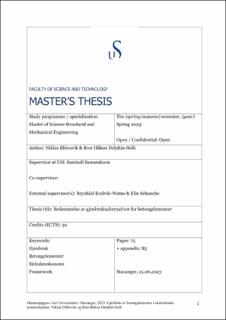| dc.description.abstract | This master´s thesis focuses on studying the possibilities of reusing existing concrete elements and the associated challenges. To address this, the thesis has developed a framework with the purpose of facilitating reuse assessments, as the current legislation and guidelines are difficult to navigate. Barriers and benefits of a circular construction industry have been thoroughly examined through extensive theoretical analysis and environmental calculations. To delve deeper into the research question, a case study was conducted involving an existing concrete wall that was desired to preserve due to its sentimental value.
In order to design the framework, it was necessary to gather all available information on current reuse practices and attempt to identify areas for optimization. The specific wall was assessed based on the framework, shaping the steps based on the experiences gained throughout the process. A visual inspection and non-destructive testing were performed on the wall to estimate its structural integrity using a modelling program with relevant load cases for different reuse options. To support the theoretical claims that a circular economy approach is more environmentally friendly, a building circularity analysis was also conducted, while other significant aspects such as technical execution and economics were discussed before presenting the final reuse proposal.
Following a comprehensive case study that discussed barriers and advantages of circular economy principles in the construction industry, the group developed a proposed framework. This could serve as a useful tool to systematize and structure the process of reuse possibilities for concrete elements, as experienced through the assessment of the specific wall in the thesis. However, the proposal´s main weakness lies in remaining a tool within a still challenging legislative framework, and despite the conducted evaluation, there may still be several barriers preventing the element but may vary slightly from case to case due to the different properties of the material. The biggest challenge associated with reuse today is the existing legislation and the linear economic practices on which society is built. To meet current climate goals, a transition to a circular economy is necessary, and only then will the industry´s enormous potential for improvement be unleashed, making practices like reuse easier to implement – and the framework will become even more relevant. | |
